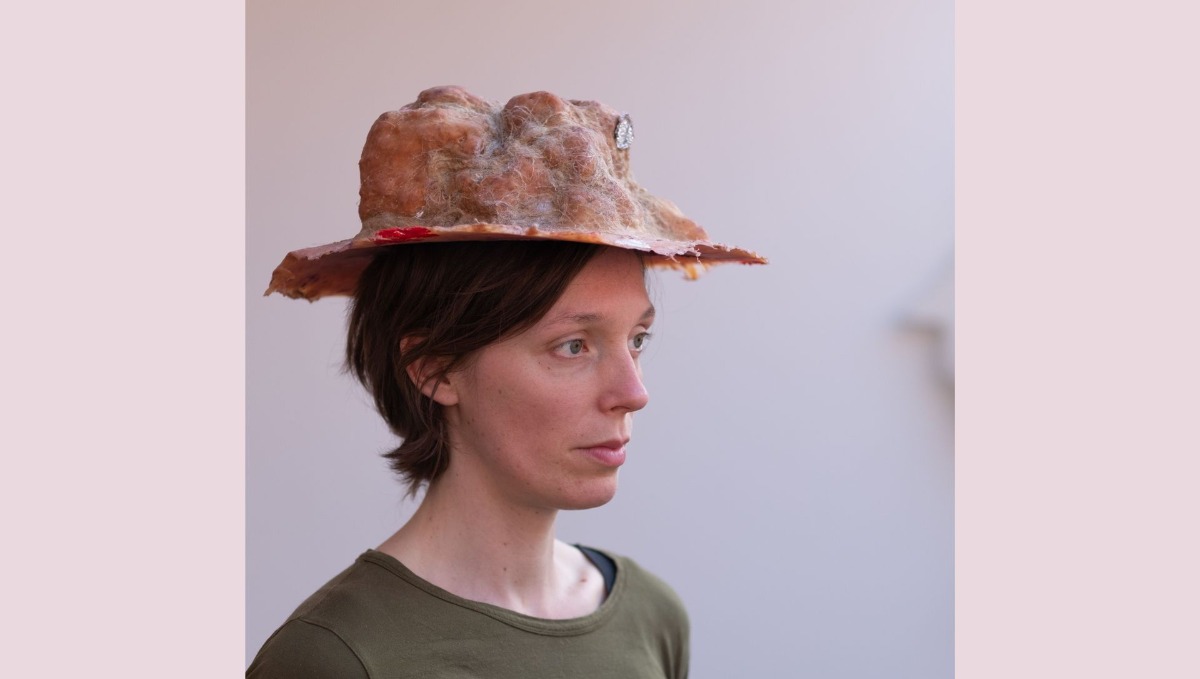
We are an island in a sea of colour
A conversation with Daiga Grantiņa / shortlisted for the Purvītis Prize 2023
Formal exhaustion has taken art from form to obsession with material, Jack Burnham wrote in 1967 in his ‘Beyond Modern Sculpture’. You could say that contemporary art was born at the moment when matter replaced form as the active principle. Daiga Grantiņa lets the material speak in a very special, unique way, which has led her to evolve into one of the most interesting voices in today’s abstract sculpture.
Her installations cannot be grasped at a single glance. A variety of levels emerge and co-exist, parallel and equal to each other, and together they create a polyphonic and open order. Clear lines and sharp angles morph into soft edges and blurred outlines. A number of different artistic principles co-exist in Grantiņa’s sculptures. Her structures and their open processuality bring forth explosive power that guides us away from predictable causalities.
Grantiņa’s works are centred around a desire to expand the potential of nonrepresentational sculpture and sort through its collective historical unconscious. She does not occupy herself with naming things; her sculpture is prelingual. The ontological line between one thing and the next one has been absorbed. At what point does a square transform into a circle and the colour green separate itself from the blue sea? Recognisable materials and forms come hand in hand with the nonreferential, involving the viewer’s imagination in a particularly dynamic manner.
Corporeal involvement in the process of viewing Grantiņa’s sculptures is inevitable since the installations reveal themselves gradually as the viewer navigates the space. She brings back corporeal movement to the physical world, which is not static and picture-like but complex, mutable and dynamic instead, the opposite to the constancy of a photograph. Grantiņa’s exhibitions are deliberately staged and acted phenomenological stories that demand complete physical immersion. And yet the goal is not replacing the existing reality with losing oneself in phantasmagoria but quite the opposite: underscoring it, announcing its presence with a joyful melody. Grantiņa always reminds us of the artificiality of her images: the edges are not finished; the fabric is attached with ordinary rivets.
Grantiņa’s approach to colour, surface, volume, objects, space and movement is distinctly multidimensional and interconnected. Her works remind us of the inconceivable totality, a part of which we all are and outside which it is impossible for us to exist. Not just infinite in terms of space, it also stretches forward and backward in time. Most of us are estranged from this part of our existence. Grantiņa’s sculpture articulates this dimension, using light and colour as a screen between us and the totality, a part of which we all are.
Installation view, “Lauka telpa” /
Art Museum Riga Bourse, Riga, 2022. Photo: Toan Vu Huu
You have been nominated for 2023 Purvītis Prize for your most extensive solo exhibition to date, at the Riga Bourse Art Museum. How did it feel to see your art universe in its entirety? How did the interaction between the works and the architecture of the building shape up? To what extent did this show serve as a milestone – a conclusion of a certain stage and a new beginning?
In this show I was interested in expanse, in expanding as a sensation. Like running across a field with your eyes closed. I showed my sculptures (or their sequels) from the last seven years, mixing them with a series of new works. I had intended to compile and expand my gestures, create a portrait of my transformations and my vocabulary. I have this sculpture entitled ‘Swallows’, around which my thoughts are still revolving. It consists of six wing-like elements that form a circular shape varying in their hues from orange to green. It has an inner and outer ring of colours. I see it as a mutable sculpture that combines the qualities of a circle and a sundial, and I can use it in different ways – depending on the place and time. I think colours are linked with a sense of time. As it accumulates, tonality becomes a rhythm and can be perceived as a gesture. This wheel of colours turns parallel to the time in our world and casts shadows that change their tones correspondingly. In terms of density, intensity and temporality, colour is a medium, an environment that is part of our own bodies, our nature.
I think that colour guides me toward form. It is a form-giving substance, like a hormone that demands movement. A centre that contains the movements of the mind and therefore lets its waters carry us. We are like islands in a sea of colour, and art is the shore.
Daiga Grantiņa. Clinging, craving. 2022. Stainless steal, bolts, varnish, 180 x 220 x 180 cm. Photo: Toan Vu Huu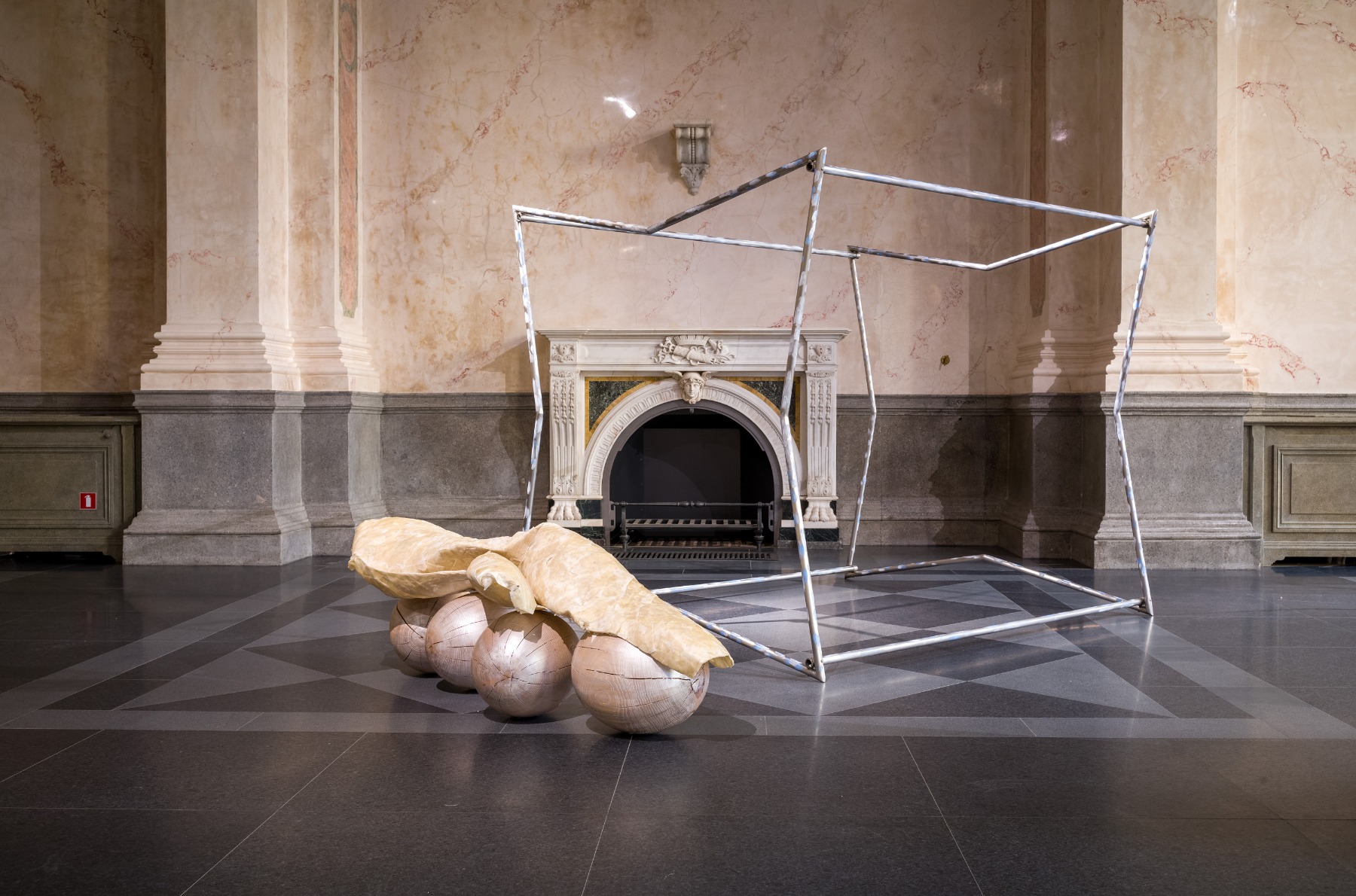
You mentioned the word ‘homecoming’ in your exhibition texts and interviews. Why is it important for you to have this connection with Latvia after almost 25 years of life and work in Western Europe? What is it that your Latvian roots add to your art practice?
It is constant coming back and leaving again. I feel like a migratory bird. It is a constant in my life, always with me since the age of seven; it provides myself with a rhythm. I find a space for my migratory experience to resonate in my works. I believe that art is connected with the most marginal of experiences, with transition between cultures and dissolution of any idea or consistency.
I associate my native land with a sense of having nature as my support to lean on; it is like becoming a part of the landscape. It is this force that I had in mind when I named the show ‘Lauka telpa’ [Field Space]. It is a tribute to this form of inspiration. It is a tribute to my family who gave me access to this inspiration.
Daiga Grantiņa. Cloud Woman, 2022. Foam, acrylic medium, ink, fabric, mirror panel, 275 x 195 x 155 cm. Photo: Toan Vu Huu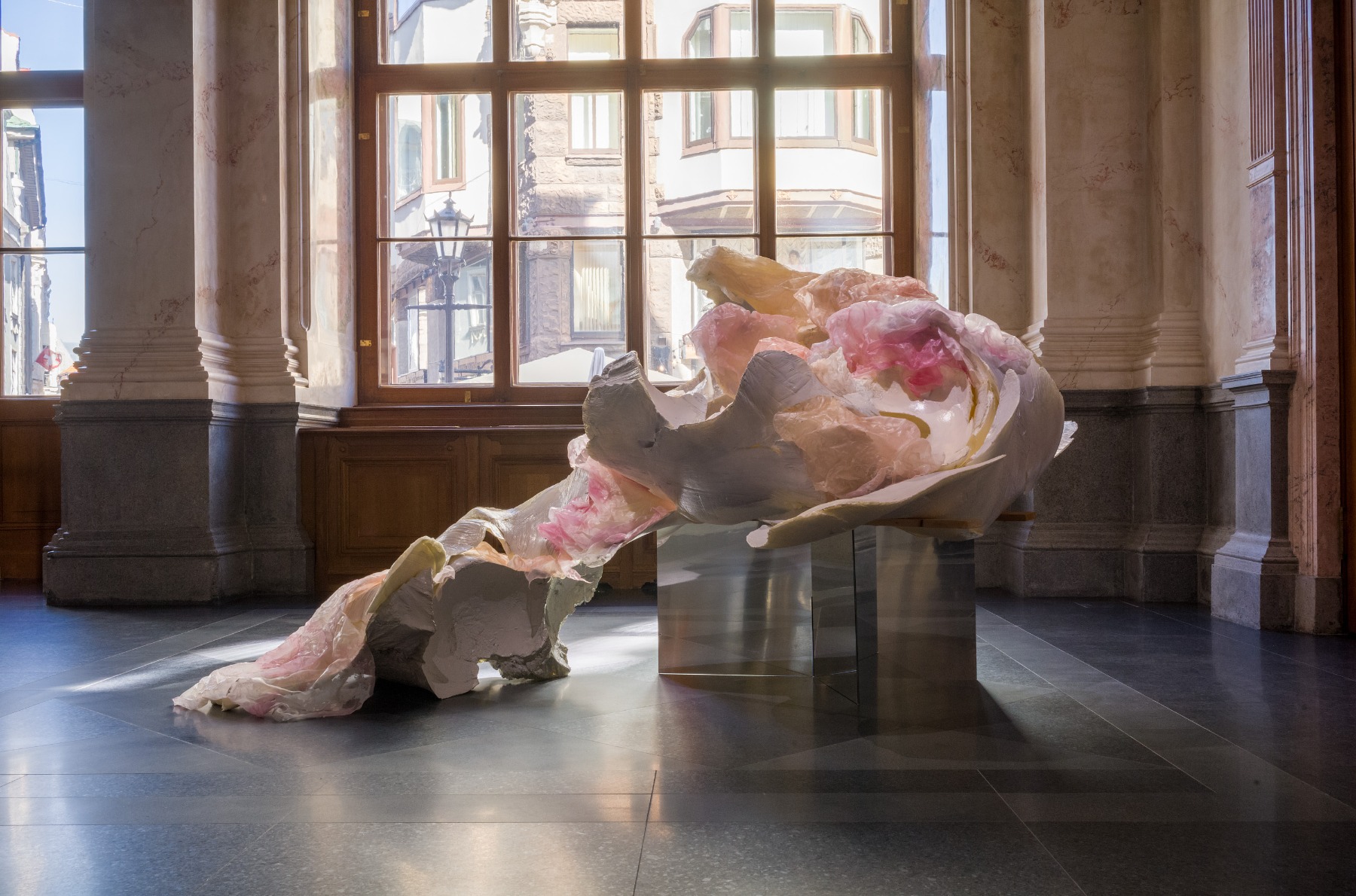
In your Riga show you used the same principle as you did at the GAMeC art gallery in Bergamo a year earlier: you aligned your works with an imaginary line – a stave that encircled the gallery room in Bergamo and a diagonal across the room in Riga. In the context of this geometry, artworks are gestures that interplay rhythmically, culminating in a sensual expression of the whole space. What is your take on the relationship between an artwork and the space? And who are you in this process – a composer, a draughtswoman, a poet or a sculptor?
Geometry has become the internal framework of the work, a sound, which I highly value, because it can bring peace into my process. Geometry seems invisible to me; I see through it. It is like vibration. The diagonals and particularly the V shape came to me while I was working with feathers. V could mean Vogel (bird), and then we perhaps could be sitting on a tree and singing. To me, artwork and space form a cohesive whole. I think these two effects can strengthen one another, just like architecture can strengthen our relationship with environment. I find the ancient methods of construction fascinating: they contain such a huge body of knowledge about the ways these civilisations worked and thought. A house can be perceived as a mediator between nature and man, a fabric of active properties. Geometry is a link with the fabric of life. In this regard it is a vibrating geometry. Language, spoken or sung, is also a vibrating geometry. Yes, and sculptures are knots in this fabric – weaved out of gestures.
Daiga Grantiņa. Bean, 2019. Tissue, artificial resin, feathers, 120 x 107 x 85 cm. Photo: Toan Vu Huu
You have said that your works experience the fullness of existence at the moment when the material interacts with the viewer’s senses. You don’t fill your works with symbolic meaning, you rely on phenomenological experience. On the one hand, it means freedom; on the other – it frequently makes people feel confused, because there is no story, no symbols to hold on to. What would you like your viewer to experience, to feel?
I do not distinguish between the way my works are in my studio and outside it. They are born from the world of my senses, and I can accompany them as far as the threshold of the doorway. The threshold, in the best-case scenario, is the exhibition.
In my experience, everything is completely transparent in art, including the confidence or insecurity that I bring into my studio. All the sensations that come from my thoughts and encounters are involved. They take on the role of a patrix. I believe that nothing is ever concealed in a work of art, not even the things that it attempts to avoid revealing. The reasons may not be obvious, but I do think that art is symbolic through and through. It is a riddle of symbolism. I believe it is a riddle, yes. I can only want something from this riddle. It is the only tangible thing for me.
Daiga Grantiņa. Bergamo bird, 2021. Branches, aluminium, fabric, silicone, ink, wire, galvanised metal, 97 x 330 x 42 cm. Photo: Toan Vu Huu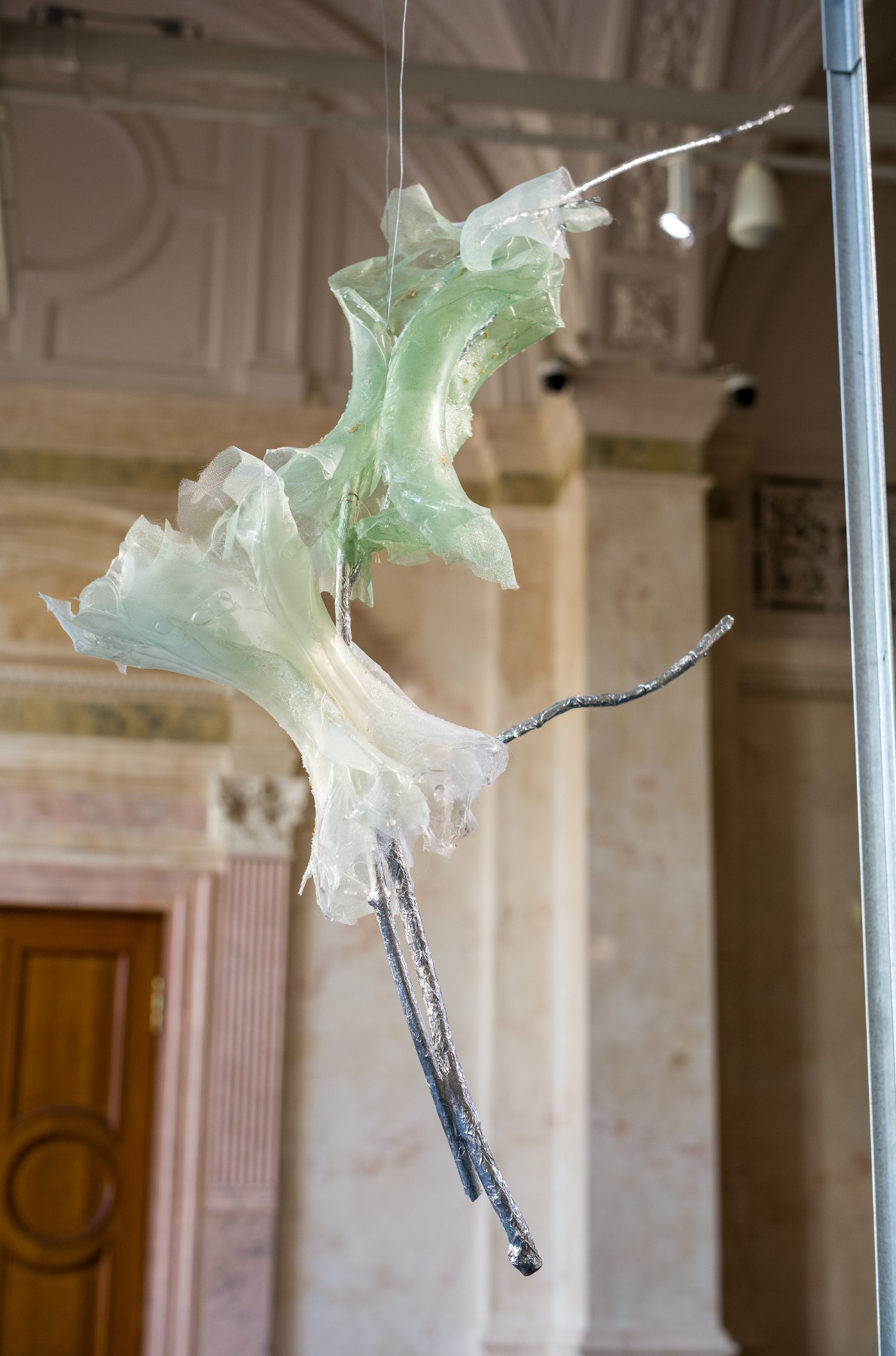
Your works challenge our sense of the stability of the world. Forms that initially seem organic and ‘random’ reveal a grid and seriality on a closer look, while the outlines of safe geometrical entities, like a square, are blurry – and the colour green is more blue than green. What is the purpose of this reverse geometry?
The idea of reverse geometry and its potential to change perception is very interesting. Through a side of a square, the option to enter the space is revealed. The side is the centre, the space. Similarly, colour manifests in a different way on the sides because it is no longer just colour in itself. It is simultaneously outside of itself: it needs a body; it is looking for the exterior. Being outside of oneself, encountering oneself without the help of a mirror, talking to yourself loudly, entering reverse geometry… I am thinking about the doors in Kuldīga: each of the doors assembles its form, its power and symbolism from an array of shared elements. The door is the house speaking; perhaps it is its reverse geometry? The purpose of the door extends to an invisible dimension and has to do with a gesture from the everyday life. The door is like colour. Colour can also let you enter, or it can close down, and it can give its house a voice.
Daiga Grantiņa. Cloud Woman, 2022 (detail). Photo: Toan Vu Huu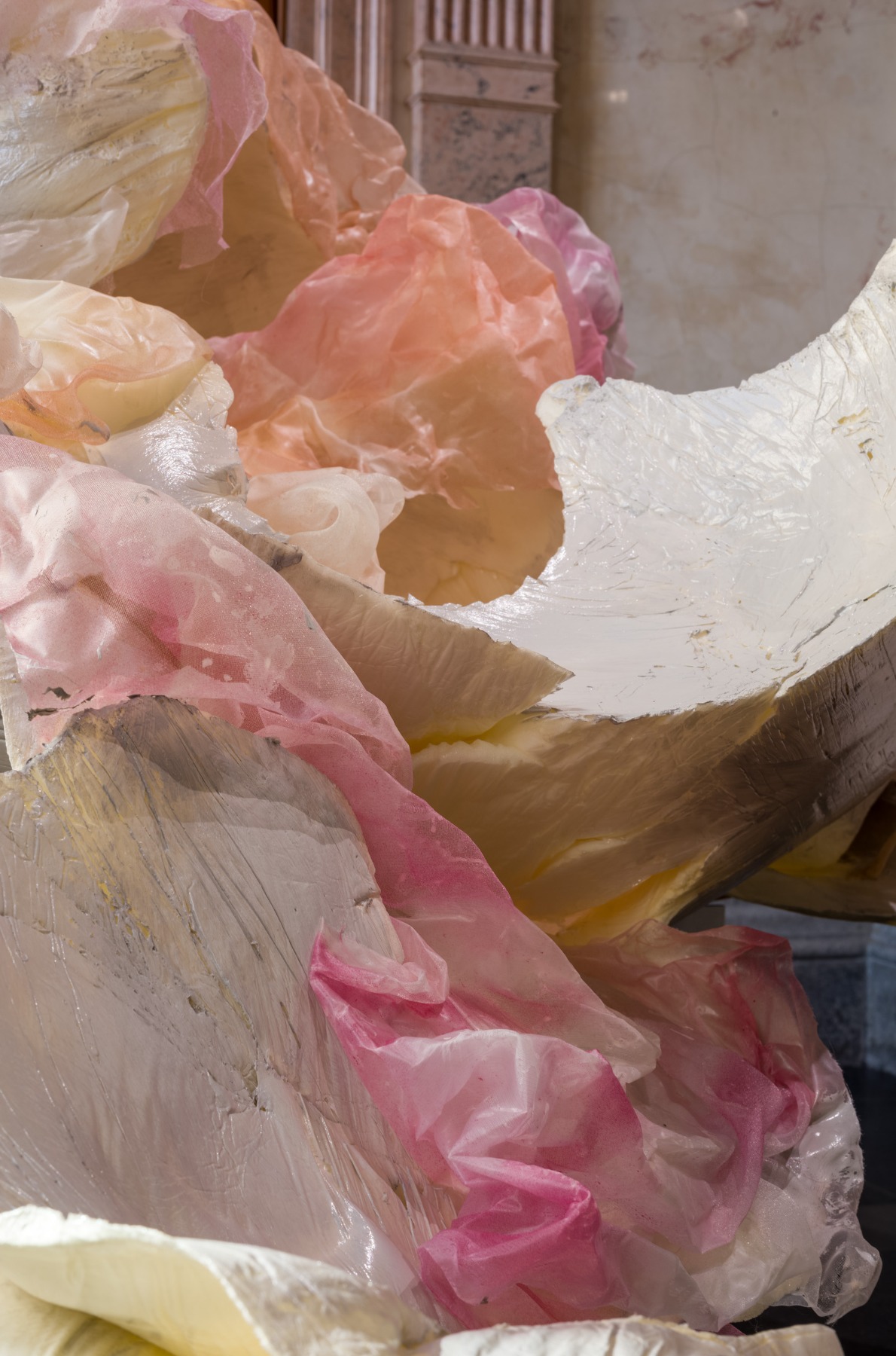
You announced yourself in contemporary art so strikingly with your surprising, not to say – occasionally – radical approach to material. Inspired by ideas from nature, body, outer space and language, your works are the product of research into harmony and dissonance between various materials. What is the most essential thing you have realised regarding our relationship with the material/matter?
Material has become my key tool, like a paint brush or a chisel; at the same time, it is also my inspiration. It has its own gesture. The studio is also part of it, like a shell that keeps these energies together and thus also becomes a part of the practice. I learn from matter and learn to insert myself into it to transform it into material. I want to experience my gesture in symbiosis with matter. I want to create a midway, like an infinite knot between matter and myself. The actual material is the energetic substance that builds this connection. The substance of inspiration.
You immediately recognise the effect of this ‘substance’; it is incomparable, like a deliberately created ambience. Therefore, material is a tangible transition to ambience. I think this transition can expand and contract like our sense of time. Inspiration is transition from darkness to the night. The important thing is this state; material is like geometry then. It is and it isn’t at the same time.
Installation view, “Lauka telpa” /
Art Museum Riga Bourse, Riga, 2022. Photo: Toan Vu Huu
You left Latvia at an early age, possibly before you had got to know the works of Vilhelms Purvītis. Do you see a common thread connecting your art with his? What does the Latvian landscape mean to you?
When I visited a Vilhelms Purvītis’ show last summer, it felt as if I already knew almost all of these paintings. I have no idea how they have found their way inside me, perhaps from books, but I have this feeling that these paintings are part of my memories. As if he had created the form of these memories. Sometimes you do not recognise the landscape, but the work demands that you stop – as if it had recognised you. And a conversation begins. It sometimes happens with certain animals, different locations and people.
I believe what characterises the cultural world of Latvia is a powerful force of abstraction. I don’t mean abstraction as an opposite to representation but a powerful connection between art and nature in a huge variety of forms. I do not distinguish between art and craft, literature, music, theatre and contemporary art. The power of abstraction is what connects us to other cultures; it is the power of being recognisable.
Daiga Grantiņa. Sarrasvati. 2020. Tissue, wood, silicone, thread, screws, 265 x 255 x 105 cm. Photo: Toan Vu Huu
Does this access to the sensory, the intuitive and the unconscious, which your practice and probably the tradition of abstract sculpture in general are associated with, also carry a moral value? Right now, for instance, at a time when the consequences of Russia’s war in Ukraine are felt so acutely in Latvia? Do you believe that art has an ethical role to play socially?
I believe that art is a shore. Roles are allocated as necessary, and art can provide us with inspiration to build our shores, rebuild ourselves.